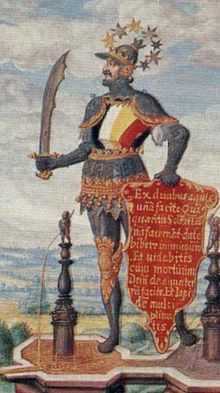- Magnum opus (alchemy)
-
For other uses, see Magnum opus (disambiguation).
 Colors of the magnum opus seen on the breastplate of a figure from Splendor Solis
Colors of the magnum opus seen on the breastplate of a figure from Splendor Solis
The Great Work (Latin: Magnum opus) is an alchemical term for the process of creating the philosopher's stone. It has been used to describe personal and spiritual transmutation in the Hermetic tradition, attached to laboratory processes and chemical color changes, used as a model for the individuation process, and as a device in art and literature. The magnum opus has been carried forward in new age and neo-hermetic movements which sometimes attached new symbolism and significance to the processes. It originally had four stages:[1][2]
- nigredo, a blackening or melanosis
- albedo, a whitening or leucosis
- citrinitas, a yellowing or xanthosis
- rubedo, a reddening, purpling, or iosis
The origin of these four phases can be traced at least as far back as the first century. Zosimus of Panopolis wrote that it was known to Maria the Jewess.[3] After the 15th century, many writers tended to compress citrinitas into rubedo and consider only three stages.[4] Other color stages are sometimes mentioned, most notably the cauda pavonis (peacock's tail) in which an array of colors appear.
The magnum opus had a variety of alchemical symbols attached to it. Birds like the raven, swan, and phoenix could be used to represent the progression through the colors. Similar color changes could be seen in the laboratory, where for example, the blackness of rotting, burnt, or fermenting matter would be associated with nigredo.
Expansion on the four stages
Alchemical authors sometimes elaborated on the three or four color model by enumerating a variety of chemical steps to be performed. Though these were often arranged in groups of seven or twelve stages, there is little consistency in the names of these processes, their number, their order, or their description.[5]
Various alchemical documents were directly or indirectly used to justify these stages. The Tabula Smaragdina is the oldest document[6] said to provide a "recipe". Others include the Mutus Liber, the twelve keys of Basil Valentine, the emblems of Steffan Michelspacher, and the twelve gates of George Ripley.[7] Ripley's steps are given as:[8]
1. Calcination 7. Cibation 2. Solution (or Dissolution) 8. Sublimation 3. Separation 9. Fermentation 4. Conjunction 10. Exaltation 5. Putrefaction 11. Multiplication 6. Congelation 12. Projection In another example from the sixteenth century, Samuel Norton gives the following fourteen stages:[9]
1. Purgation 8. Conjunction 2. Sublimation 9. Putrefaction in sulphur 3. Calcination 10. Solution of bodily sulphur 4. Exuberation 11. Solution of sulphur of white light 5. Fixation 12. Fermentation in elixir 6. Solution 13. Multiplication in virtue 7. Separation 14. Multiplication in quantity Some alchemists also circulated steps for the creation of practical medicines and substances, that have little to do with the magnum opus. The cryptic and often symbolic language used to describe both adds to the confusion, but it's clear that there is no single standard step-by-step recipe given for the creation of the philosopher's stone.[10]
Magnum opus in literature and entertainment
Further information: Alchemy in art and entertainmentSometimes an artist's magnum opus is modeled around the alchemical magnum opus. More than simple mention of alchemy within the story, masterpieces like Finnegans Wake[11] follow the process of transmutation, weaving their entire narrative with alchemical symbolism.[12] The scholarly journal, Cauda Pavonis which had been published out of various universities since 1980, explored these connections in art and literature. Recently, John Granger has coined the phrase literary alchemy[13] to describe these trends in popular fiction.
References
- ^ The-Four-Stages-of-Alchemical-Work
- ^ Joseph Needham. Science & Civilisation in China: Chemistry and chemical technology. Spagyrical discovery and invention : magisteries of gold and immortality. Cambridge. 1974. p.23
- ^ Henrik Bogdan. Western esotericism and rituals of initiation. State University of New York Press, Albany. p.197
- ^ Meyrink und das theomorphische Menschenbild
- ^ Stanton J. Linden. The alchemy reader: from Hermes Trismegistus to Isaac Newton. p.17
- ^ it is unclear if the text originates in the Middle Ages or in Late Antiquity, but it is generally assumed to predate 1150, when Gerard of Cremona translated it from the Arabic (Mircea Eliade, History of Religious Ideas, vol. 3/1)
- ^ From George Ripley's Compound of Alchymy. (1471)
- ^ Stanton J. Linden. The alchemy reader: from Hermes Trismegistus to Isaac Newton. p.17
- ^ Mark Haeffner. Dictionary of Alchemy: From Maria Prophetessa to Isaac Newton. p.238
- ^ Mark Haeffner. Dictionary of Alchemy: From Maria Prophetessa to Isaac Newton. p.237
- ^ Barbara DiBernard. Alchemy and Finnegans Wake. SUNY Press, 1980.
- ^ For details from English literature, see Stanton J. Linden. Darke Hieroglyphicks: Alchemy in English Literature from Chaucer to the Restoration. University of Kentucky Press. 1998.
- ^ John Granger. The Alchemist’s Tale Harry Potter & the Alchemical Tradition in English Literature
Categories:
Wikimedia Foundation. 2010.
